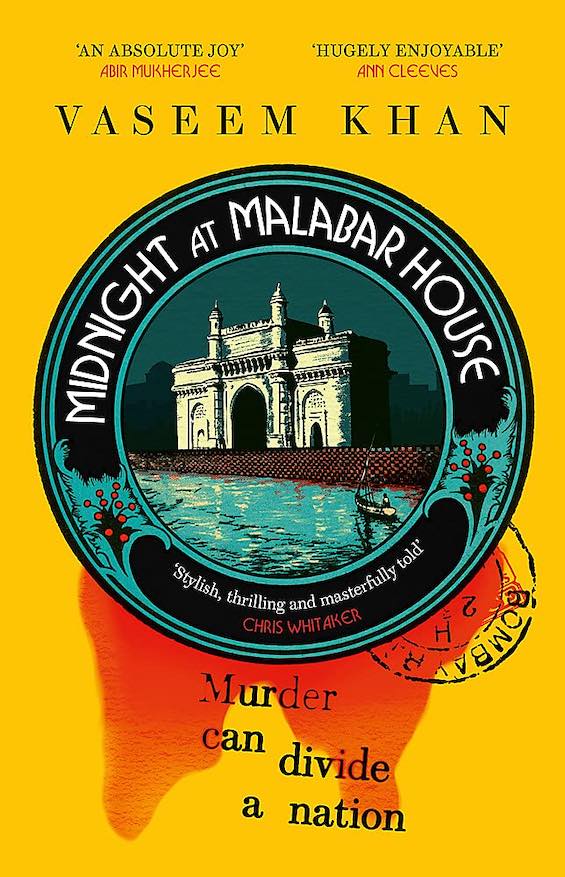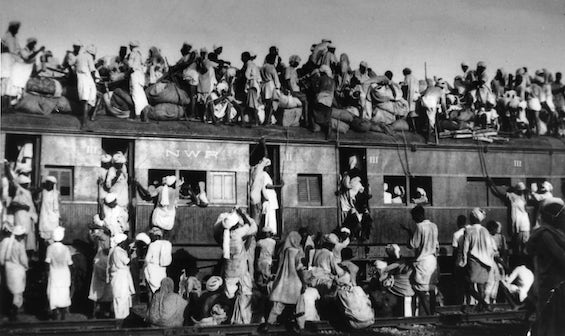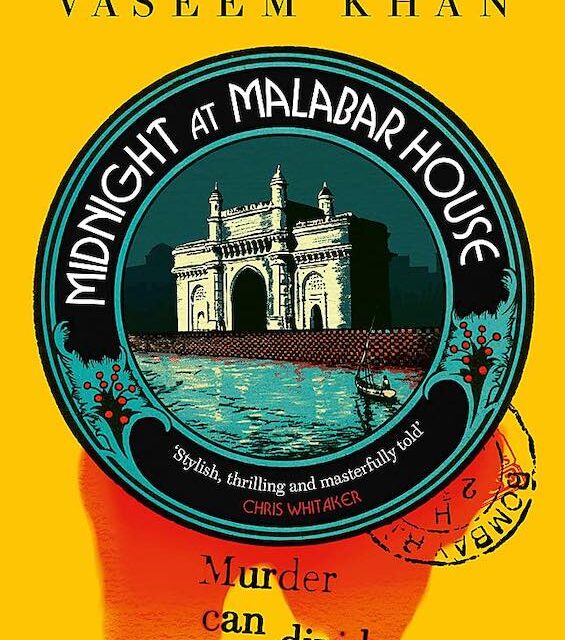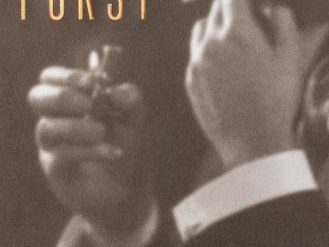
Estimated reading time: 7 minutes
Some historical mysteries use history as a stage set, with the events and fashions of the time as no more than exotic stage sets. In others, the action serves as a gateway to the history of the period. Vaseem Khan’s intriguing debut, Midnight at Malabar House, is among the latter. The novel delves deeply into the tragic events that unfolded in India after Partition (1947), when the Indian subcontinent was violently split asunder into the nations of India and Pakistan. Millions died in the intercommunal fighting that ensued. Their ghosts haunt this novel.
An Englishman is murdered
Midnight at Malabar House opens shortly after the stroke of twelve on January 1, 1950. We find ourselves in Bombay, two years after the Partition of India. Sometime during the course of a lavish costume party to celebrate New Year’s Eve at his palatial mansion, Sir James Herriot has died at the desk in his study, viciously stabbed to death. A senior British advisor to the new Indian government, Sir James was both wealthy and popular. His chief aide, Madan Lal, calls a nearby police station, Malabar House, to report the murder and request assistance. Inspector Persis Wadia takes the call. And it is she who will lead the complex, months-long investigation to identify and capture the murderer.
Midnight at Malabar House (Malabar House #1) by Vaseem Khan (2020) 415 pages ★★★★★

The first policewoman in Bombay
Persis Wadia is the first woman ever admitted to the Bombay Police, and she pays the price on a daily basis. Even her own family struggles with her choice of profession. She is also a Parsi, a member of a tiny Zoroastrian religious minority, which sets her further apart from the overwhelmingly Hindu force. Few of the officers at Malabar House—indeed, few anywhere in the police—are willing to admit that a woman belongs in the department. And Parsis are, well, different. But Persis is both tough and brilliant.
She is also socially awkward and possesses a hair-trigger temper. She does not take insults lightly. Which doesn’t go down well in the misogynist environment of the Bombay Police or the elite society into which the murder of Sir James Herriot has drawn her. Predictably, even Persis’ father complains about her work. He detests the British and is angry she would investigate the murder of an Englishman. And her Aunt Nussie insists the young woman find a nice Parsi boy and settle down.
Far more than a whodunit
On one level, Midnight at Malabar House is a whodunit. The suspects multiply as Persis pushes past the meager facts of the case. There’s Madan Lal, Sir James’ aide, formerly a major in the Indian Army at the decisive World War II Battle of Imphal. Robert Campbell, a wealthy Scots businessman with whom Sir James recently fell out. Campbell’s daughter, Elizabeth, who was reportedly having an affair with Sir James. Eve Gatsby, a wealthy young American woman who might also have been intimate with him. Maan Singh, the Englishman’s six-foot-six Sikh driver and bodyguard. Lalita Gupta, the cook. Yet others emerge as the story unfolds. But there’s a lot more going on than sifting through a gaggle of suspects.
One big structural flaw
Unfortunately, to unwind this unlikely surplus of suspects, Khan resorts to a clever and entirely unbelievable trick common in English drawing-room mysteries. He gathers them all in a single room and provokes them to reveal all their crimes and other misbehavior to one another—at a funeral, no less. Naturally, the killer attempts to flee. The artificiality of this scene is a huge disappointment after the artful development of the plot in the months leading up to the funeral.
The roots of the murder lie in Partition
From the outset, Persis strongly suspects that Sir James’ top-secret work for the Indian government must be connected to his murder. She learns about that work through the connections of an Englishman named Archimedes (“Archie”) Blackfinch, a criminalist who has been dropped into the case as her collaborator. Sir James had been charged by the Indian Home Office with investigating allegations of crimes against humanity during Partition. And as Persis pursues the possible links between one of these crimes and his New Year’s Eve murder, she learns to her horror far more than she had known before about the tragic reality of Partition. There is a connection, of course. But you’ll be surprised when you learn what it is.
Partition was the price for Indian independence
The Partition of India and Pakistan on August 15, 1947 was one of the most dramatic events of the 20th century. In the west of the subcontinent, the massive province of Punjab—home to millions of Sikhs as well as Muslims and Hindus—was cleaved in half. Muslims by the million fled north and west into what was now Pakistan; Sikhs and Hindus bolted in the opposite direction, seeking shelter in India. And in the east, in the densely populated province of Bengal, already split into western and eastern halves, millions more moved across the border in abject fear. By the best estimates, some 1.5 million people died and 15 million were displaced from their homes. The numbers might well have been much larger.
There was nothing accidental or spontaneous about any of this. Partition was the result of an agreement hacked out in a single month by the English Governor-General Lord Louis Mountbatten (1900-79), Jawaharlal Nehru (1889-1964), leader of India’s Congress Party, and Muhammed Ali Jinnah (1876-1948), whose demands for an independent Muslim state made Partition necessary. Mohandas Gandhi raised strenuous objections but was ignored.
About the author

Vaseem Khan (1973-) has written nine mystery novels and novellas set in India, including the five in the Baby Ganesh Detective Agency series. Midnight at Malabar House is the first of what are to date two novels in a newer series. Khan is British but worked on the subcontinent for a decade as a management consultant. Wikipedia reports that “Khan wrote for over twenty years before he was published, completing half-a-dozen unpublished novels and collecting numerous rejection slips. He uses his own example to offer advice to young writers who he recommends ‘write, write and then, when you’re sick of it, write some more.'”
For related reading
This is one of 26 mysteries to keep you reading at night.
I’ve also reviewed three other books in this series:
- The Dying Day (A baffling mystery based on ciphers)
- The Lost Man of Bombay (A baffling murder mystery in post-Independence India)
- Death of a Lesser God (Murder in the shadow of Partition)
See Midnight’s Furies: The Deadly Legacy of India’s Partition by Nisid Hajari (An insightful history of the Indian Partition).
Check out the novels about Perveen Mistry, India’s first female attorney, who investigates murders in Bombay more than a quarter-century earlier than Persis Wadia:
- The Widows of Malabar Hill (The first woman lawyer in Bombay solves a baffling mystery)
- The Satapur Moonstone A murder mystery set in colonial India highlights the princely states
- The Bombay Prince (Murder in Bombay during the Indian independence movement)
Take a look, too, at Good books about India, past and present.
You might also enjoy my posts:
- Top 10 historical mysteries and thrillers reviewed here
- Top 10 mystery and thriller series
- 20 excellent standalone mysteries and thrillers
- 30 outstanding detective series from around the world
And you can always find my most popular reviews, and the most recent ones, on the Home Page.



























